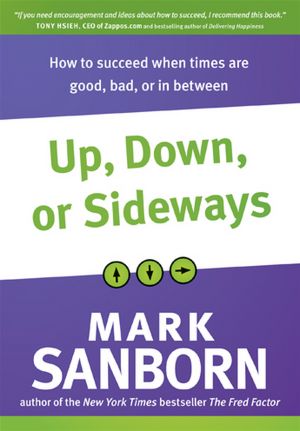 Mark Sanborn is a great speaker. One of the best. He’s also a great writer. That’s why I try to read everything he writes. If you want a sample of some of his insights, I encourage you to subscribe to his blog.
Mark Sanborn is a great speaker. One of the best. He’s also a great writer. That’s why I try to read everything he writes. If you want a sample of some of his insights, I encourage you to subscribe to his blog.
Reading through his latest book, Up, Down, Or Sideways is like sitting across the table from a dear friend who has nothing but your best interests at heart. Mark shares about a recent period in his life where it seemed that his difficulties compounded one on top of the other. He knows what it’s like to face crisis personally and professionally. Yet the beauty of this book is the simple reminders about the best ways we can respond in the midst of these difficult situations. He calls them, the “good shoulds.”
Is this book worth reading? Absolutely. I read the whole thing in one sitting. Yup…it’s that helpful.
Sanborn has a gift for weaving his own personal and thought-provoking anecdotes within well-researched principles. The book is divided into three sections: See. Think. Do.
The section on See encourages the reader to have the right perspective in the midst of life’s circumstances (both good and bad) and to continue to do the right thing even when things aren’t going the right way. My favorite quote from this section said,
“Rather than focusing on what might happen, focus on what you can do now to ensure you’ll be successful regardless of what happens. Rather than trying to predict the future, prepare for it. Rather than anticipating what the world will throw your way, adopt and live out the timeless principles that will serve you, come what may.”
The section on Think addresses what we measure, what our attitude looks like, and the opportunities we have to learn through each and every experience. Sanborn offers solid evidence and an optimistic prescription for the way our thinking energizes us or depletes us during difficult times. One of the things I really began to notice as I was reading through this section is Sanborn’s ability to write in an almost poetic fashion without sounding cliche’. He leaves you with a memorable word pictures and phrases that you can latch onto (like “be skeptical but not cynical” or “think on the noble and necessary”) and carry around in your thinking.
The final section, entitled Do is all about putting your perspective and thinking into action. Each chapter title starts is oriented toward action – Produce Value, Create and Keep Connections, Continuously Innovate, Build Reserves, Practice Gratitude, and Embrace Discipline. Once again, these are all things one “should” be doing, especially when times are difficult.
I’ve been thinking about the various takeways from the book since I finished reading it. One of the other quotes that stuck out to me was in the chapter on building reserves. Sanborn talks about an economic professor who taught him this principle: “A little saved or developed regularly equals a lot available consistently.” It’s true in economics and it’s true when it comes to self-discipline. I am challenged by this book to be a person who consistently does the right thing, as well as the necessary thing, despite the circumstances. I also want to be the same person, not emotionally tossed-around by my circumstances.
If you find yourself struggling to make it through the current season of life, I encourage you to read Mark’s book (and bring your highlighter).
Share this Post
